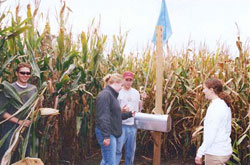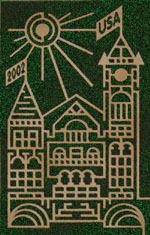





Lost in the Maize:
Corn mazes offer
unique adventure
by
Anna Thayer
 |
| Corn maze visitors pause at a checkpoint.
Checkpoints provide clues on how to get out of the maze.
Photo by Anna Thayer. |
Katie Wilkinson spent
last weekend lost inside a woolly mammoth in Lodi. After traveling through
the mammoth’s stomach, eyes and tail, she found her way out through
one of its tusks.
The woolly mammoth Wilkinson got lost in is this year’s design at
the Treinen Farm corn maze, part of a growing farm trend.
A corn what?
Corn mazes like the one Wilkinson visited are a relatively new
form of entertainment. The first corn maze was created in Pennsylvania
in 1993 as a partnership between the American Maze Company and world-renowned
maze designer Adrian Fisher. That maze, which earned the title “World’s
Largest Maze” in the Guinness Book of World Records, was created
as a fund-raiser for the victims of the Midwest floods.
After that, the corn maze craze spread across America as farmers struggling to earn a living and keep their land turned to “agritainment,” offering farm tours, hay rides and, now, corn mazes.
“With farmers struggling so much in traditional farming, corn mazes offer an alternative way for them to hopefully keep their land and make some money,” says Kamille Combs, public relations director of The MAiZE, a Utah-based corn maze design company that has designed mazes in Wisconsin.
With corn mazes gaining popularity in the United States, farmers are finding a great deal of profit. Most Wisconsin mazes are open every weekend (weather permitting) throughout September and October. Maze owners in Wisconsin estimate a typical weekend brings about 200 to 300 visitors, at an average ticket price of $5 to $7. And at the end of each season, the farmers still harvest the corn, so they profit both from their harvest and from their maze.
“It’s a great situation for farmers,” says Andrea Hughes, a corn maze designer whose Madison-based Event Management Company also offers seminars on how to run a successful corn maze. “They are maximizing the money they get from their fields.
The only problem is they can’t run a successful corn maze if they don’t know how to draw in visitors.”
More than just a trail in the corn
 |
The 2002 Treinen Farm maze design was
a woolly mammoth. |
One method maze owners use to draw visitors is the maze design. On the ground, corn mazes look like normal cornfields, but from the air, most are elaborate designs. Take, for example, the Treinen Farm woolly mammoth Katie Wilkinson visited. “When you’re inside the maze, it just seems like you’re turning circles in a corn field,” Wilkinson says. “It’s hard to imagine that the path you’re on actually forms some part of the design you see on the map.”
And those elaborate designs would be hard to get without the help of maze design experts, such as The MAiZE or Hughes’ Event Management Company.
Although the specifics of each company’s design process vary, one of two general methods usually is employed: GPS (Global Positioning System) or the grid method. In both cases, the company designs an image on a computer that fits the dimensions of a specific cornfield. Using the GPS method, cutters go through a maze with a computer using GPS to determine how far to go, when to turn and in which direction. With the grid method, which Hughes uses, posts are placed in the cornfield dividing it into equal-size boxes, and the computer-designed image is divided into boxes of the same size. From there, it is just a matter of cutting each cornfield grid to match its corresponding grid on the computer image.
It may sound simple, but this process can cost a farmer anywhere from $5,000 to $50,000, depending on how large and elaborate the maze is. These prices include the design process and the cutting process, which, Hughes says, can be done by hand when the corn is small or by lawn tractors.
Because of the cost, some corn maze owners, such as Janell Stacey, whose maze is located in East Troy, choose to forgo the designs. “We don’t do the fancy designs that you see on some corn mazes,” Stacey says. “Those mazes look great from the sky, but once you are in the maze you don’t see any of that.”
Whether an elaborate design or simply a maze, what matters most to an owner is making a maze fun for the people who come to visit.
Just follow the
signs
Most
corn mazes average about two miles of trails that twist and turn and frequently
come to dead ends. Maze owners estimate that someone who goes in focused primarily
on finding a way out should find the exit in one to two hours. And for anyone
worried about not finding the way out, most mazes either give flags to carry,
or have workers stationed throughout the maze. In addition, a majority of
the Wisconsin mazes have checkpoints, which are usually the key to finding
the exit. Some maze checkpoints, for example, have questions or riddles.
“Before I switched to solely designing, we ran the Wisconsin Sesquicentennial maze,” Hughes says. “And we had questions scattered throughout the maze. Each question was multiple-choice and each answer told you to go in a different direction. So the more knowledgeable you were about that particular topic, which for ours was Wisconsin, the faster you got out.”
Other mazes give visitors an incomplete map and each checkpoint contains another piece of that map. The visitor needs to find the first checkpoint to know where the next one is located.
But most mazes also offer a more challenging experience for those who are willing. For example, many offer the corn maze version of hide-and-go-seek. These mazes have items, such as paper-hole punchers or stamps, attached to posts hidden throughout the maze. The posts can be anywhere, so visitors need to search every dead end and every wrong turn. If a visitor collects a certain number of punches or stamps on a card or a map, they win a prize or are entered in a raffle.
Finally, many corn maze owners have found success in bringing in customers by offering haunted mazes some nights in October. Because it is dark, visitors enter the maze with glowsticks or flashlights, and should be prepared to be scared. “We hired some young kids, [ages] 13 or 14, to come in and hide in the maze,” Hughes says. “They would lie on the ground in the cornfield and then grab the ankles of people who passed by. When you’re lost in a corn maze in the dark and someone grabs your ankle, that can be pretty scary.”
A corn-y way to spend the weekend?
 |
| The 2002 Windmill Hill maze design is the
Green County Courthouse. Maze visitors can find unique rooms, such
as the judge's chambers. Photo courtesy of Windmill Hill Corn Maze |
The incentives offered by owners make the mazes more challenging to visitors, but they aren’t what draw people to corn mazes. In fact, most visitors don’t know they will do anything other than get lost in a maze.
“I think that the main draw for corn mazes is the challenge,” Hughes says. “People are intrigued by the idea of getting lost and finding their way out.”
Other visitors are just looking for something fun and active to do with their families. “One of the great things about corn mazes is that they offer a level playing field,” says Hughes. “The parent is no better equipped to make it through than the child. There is no age requirement, and yet they are equally challenging to all age groups. Furthermore, it’s outdoors. It’s not sitting in front of the TV. And there’s no time limit, so visitors can stay as long as they like.”
Some visitors become maze fanatics, visiting as often as they can during the season. “We definitely see a lot of repeat customers,” Hughes says. “A nice thing about corn mazes is that you can’t memorize them, so you can keep coming back to the same place. And even if you learn your way around one pretty well, it will be completely different next year.”
Finally, corn mazes offer a unique venue for group outings. “Mazes can help build teamwork and unity for churches or companies,” Combs says. “They also provide an educational experience for school groups. Children can come and get a talk from the farmer about agriculture before going in the maze. And, of course, mazes are a great location for parties because they are something different and something fun.”
And no matter what the reason for visiting, or how long one chooses to stay, everyone seems to leave with the same opinion:
"I didn’t know what to expect, but it ended up being a lot of fun,” says Steven Reuhl, a student from Appleton. “We broke up in two teams and competed against each other to see who could find all the hole punches first. I’d definitely like to visit another maze.”
That sentiment seems
to echo resoundingly among maze visitors.
“This was my first visit to a corn maze,” says Matt Lee, a legal
assistant from Madison. “But I want to take my girlfriend to a different
one next weekend. And I’d like to try a haunted maze too.”
In a field near
you
Clearly,
corn mazes offer something for everyone. Visitors spend an enjoyable afternoon
lost amid tall, golden stalks of corn. Owners find decent profits beyond traditional
farming. And Katie? She’s willing to challenge the mammoth a second
time.